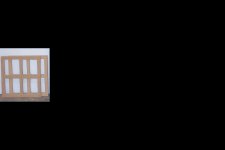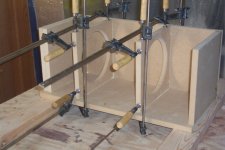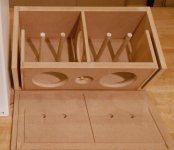Bob, What's a window brace?
A window brace is a piece of plywood,whatever, that fits between the sides of the cabinet and has a hole(s) in it. The classic window brace has an X across the cabinet. I generally use a brace with a circular or elliptical hole in it.
Bob
Attachments
Would it be helpful in reducing resonances to double (sister?) mdf with ply?
As in glue the two types boards together to make one thicker board?
concerning window braces: i have heard from many seasoned speaker builders that it is important to space the braces unevenly, so the resulting panes of wood (between the braces) have different sizes/length. That puts them at different resonant frequencies.
As in glue the two types boards together to make one thicker board?
concerning window braces: i have heard from many seasoned speaker builders that it is important to space the braces unevenly, so the resulting panes of wood (between the braces) have different sizes/length. That puts them at different resonant frequencies.
Sayrum,
Are you familiar with Klang & Ton and Hobby-HiFi both of them have published measurements of various braces and laminations?
Are you familiar with Klang & Ton and Hobby-HiFi both of them have published measurements of various braces and laminations?
Would it make any sense to add an sligtly oblique brace? E.g. a brace that runs from somewhere top-right to somewhere bottom left (and connects front and rear panels)? I'd say that would break a lot of wavelengths.. or am I missing something?
sayrum:
If not going for the light / stiff approach and targeting for fast dissipation of inevitable panel resonances, I'd be inclined towards something like constrained layer damping , with 2 layers of thinner plywood, and an intermediate resilient material (such a rubber / bending ply), rather than using the heavy mass of MDF.
of course, I'm not a fan of MDF for speaker enclosures in general (well, it can make for great routing patterns and grille frames 😀)
grandemahatma:
depending on the principle of design of the enclosure, an oblique /diagonal brace, even with a lot of open space, might interfere with the operation even more than horizontal window braces - I'm thinking particularly of something like an MLTL or BLH
If not going for the light / stiff approach and targeting for fast dissipation of inevitable panel resonances, I'd be inclined towards something like constrained layer damping , with 2 layers of thinner plywood, and an intermediate resilient material (such a rubber / bending ply), rather than using the heavy mass of MDF.
of course, I'm not a fan of MDF for speaker enclosures in general (well, it can make for great routing patterns and grille frames 😀)
grandemahatma:
depending on the principle of design of the enclosure, an oblique /diagonal brace, even with a lot of open space, might interfere with the operation even more than horizontal window braces - I'm thinking particularly of something like an MLTL or BLH
Would it make any sense to add an sligtly oblique brace?
Yes. But as Chris says, only as long as it does not interfere with speaker function
dave
depending on the principle of design of the enclosure, an oblique /diagonal brace, even with a lot of open space, might interfere with the operation even more than horizontal window braces - I'm thinking particularly of something like an MLTL or BLH
Chris,
Could you elaborate on this a little. I'm genuinely curious (and don't have the kind of experience you seem to have when it comes to assessing these kinds of effects).
I could be all wet, but I'm thinking that in 1/4 wave designs such as an MLTL - of which the Pensil is a family member - that a structural member such as a diagonal brace without sufficient openings (and who knows what that means?) or very large cross section window brace could impede the longitudinal wave action enough to affect operation. Meaning the diffraction/ reflections that I'd assume would result would not benefit the intended wave action.
For a combination of that supposition, and the practical simplicity of using just 90dg cuts, I run my own bracing on such designs in the vertical /longitudinal direction, so the cross sectional area is limited to material thickness x widths.
But now we can let the real experts expound on the question.
Dr Moose, GM, et al?
For a combination of that supposition, and the practical simplicity of using just 90dg cuts, I run my own bracing on such designs in the vertical /longitudinal direction, so the cross sectional area is limited to material thickness x widths.
But now we can let the real experts expound on the question.
Dr Moose, GM, et al?
Last edited:
Just to be sure, by longitudinal brace you mean connecting front and rear panel, right?
Last edited:
This is what I've been doing for bracing, I think it makes sense.
- double 1/2" medex laminated for front and back
- 3/4" sides/top/bottom
- center brace
- dowels as shown (3/4")
The ploy is that the front/back/side are super strong and top/bottom are small enough where bracing is not needed.
- double 1/2" medex laminated for front and back
- 3/4" sides/top/bottom
- center brace
- dowels as shown (3/4")
The ploy is that the front/back/side are super strong and top/bottom are small enough where bracing is not needed.
Attachments
Last edited:
From my experience, window braces act as if they are stuffing. I think it is possible to use cross-section restrictions in place of stuffing. However, it would be a nightmare to get right and still have nothing more that a wad of polyfill.
Bob
Bob
Hey,
maybe this is of interest.
German article on sound transmission through cabinet walls (19mm Mdf) with detailed measurements of the effect of different size braces and different cabinet lining.
And here measurements of different thicknesses of mdf + various other materials for cabinet building.
I found all these with Google so i hope it is ok to post it here. If not please tell me and i will remove it.
maybe this is of interest.
German article on sound transmission through cabinet walls (19mm Mdf) with detailed measurements of the effect of different size braces and different cabinet lining.
And here measurements of different thicknesses of mdf + various other materials for cabinet building.
I found all these with Google so i hope it is ok to post it here. If not please tell me and i will remove it.
Last edited:
IIRC in the past a basslist member reported that Kodak used birch plywood to send unexposed films in. They all became exposed. After the chernobyl disaster Baltic Birch would be radioactiv.
Hi all,
I'm going to start working on a pair of fullrange speakers, but: MDF of plywood? I can choose between any thickness from 18 to 25mm for either materials, and price is going to be comparable, but I wonder which of the two is suggested and why.
NB the build is a Pensil from frugal-phile, ca. H:100cm L:35cm W:25cm. I could imagine that MDF could be more stable, being much more heavy, but I'd like to listen to your suggestions.
Thanks all
AC
plywood and chipboard
Bob and Chris, Thanks for clearing this up.
From my experience, window braces act as if they are stuffing. I think it is possible to use cross-section restrictions in place of stuffing. However, it would be a nightmare to get right and still have nothing more that a wad of polyfill.
Bob
Hey,
maybe this is of interest.
German article on sound transmission through cabinet walls (19mm Mdf) with detailed measurements of the effect of different size braces and different cabinet lining.
And here measurements of different thicknesses of mdf + various other materials for cabinet building.
I found all these with Google so i hope it is ok to post it here. If not please tell me and i will remove it.
Impressive. I'm still not going to build my speakers with cement and tiles, but it's a nice comparison of mdf (of different sizes), plywood and several kind of stuffings.
Will vertical bars running on the side panels influence the mltl design?
Last edited:
Impressive. I'm still not going to build my speakers with cement and tiles, ...
Just estimate the amount of space taken up by the tiles + mortar. They are also helpful for increasing weight/mass of subwoofer cabinets...
sayrum,
Your first link is an HTML page on which Google translate did a passable job. The second is a PDF and unfortunately, my last contact with German was in college some 50 years ago. Do you have a link to the original HTML?
Bob
Your first link is an HTML page on which Google translate did a passable job. The second is a PDF and unfortunately, my last contact with German was in college some 50 years ago. Do you have a link to the original HTML?
Bob
Hey Bob,
here and here i found parts of the pdf as a html.
most graphs are missing though...
afaiu, they focused on mdf. different thicknesses in comparision to slate (beeing the best material for reducing transmission of soundwaves) and only one thickness of ply. Sadly no measurements of combined wall materials (mdf + ply ie.).
here and here i found parts of the pdf as a html.
most graphs are missing though...
afaiu, they focused on mdf. different thicknesses in comparision to slate (beeing the best material for reducing transmission of soundwaves) and only one thickness of ply. Sadly no measurements of combined wall materials (mdf + ply ie.).
- Status
- Not open for further replies.
- Home
- Loudspeakers
- Full Range
- mdf or plywood?


